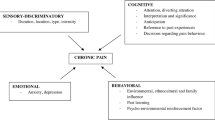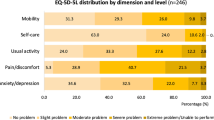Abstract
Introduction
Pain intensity is a good parameter to assess effective treatment of cancer and palliative care. The Memorial Pain Assessment Card (MPAC) is a quick, easy and reliable measure of quality of life in cancer patients. The MPAC was validated in Spanish in 2004. This study evaluated the sensitivity to change Spanish version of the MPAC.
Material and methods
An epidemiological, prospective, 1-month, multicentre study, conducted at 4 oncology services. Patients evaluated suffered chronic cancer pain and were in a susceptible situation of change. The MPAC was administrated at baseline, at one week and at one month, including the 4 subscales (pain relief [VASPR], pain intensity measured by VAS [VASPI] and by an 8-item descriptor [Tursky], and psychological distress [VASMOOD]). Satisfaction of patients and health-care professionals with the MPAC was also evaluated.
Results
A total of 54 patients were studied. All of the MPAC subscales showed sensitivity to change during the follow-up. The subscale values at visit 1 vs. visit 3 were: VASPR 4.5±1.9 vs. 6.3±2.3, VASPI 6.6±1.6 vs. 3.5±1.9 and VASMOOD 5.5±2.1 vs. 4.0±2.1). Patients and healthcare professionals agreed in the facility use MPAC card (63% and 71% of cases, respectively).
Conclusions
The present study showed sensitivity to change among the different MPAC subscales of the Spanish version. Moreover, the MPAC Spanish version has proven to be a good tool accepted by health-care-professionals and patients. Due to its facility of administration, it may allow a useful and quick evaluation of cancer-related pain in the clinical practice.
Similar content being viewed by others
References
World Health Organization (1990) Cancer pain relief and palliative care: report of an expert committee. World Health Organization, Geneva
Schug SA, Zech D, Dorr U (1990) Cancer pain management according to WHO analgesic guidelines. J Pain Symptom Manage 5:27–32
Namazi H (2008) A novel use of botulinum toxin to ameliorate bone cancer pain. Ann Surg Oncol 15:1259–1260
Greenwald HP, Bonica JJ, Bergner M (1987) The prevalence of pain in tour cancers. Cancer 60: 2563–2569
Kornblith AB, Thaler HT, Wong G et al (1995) Quality of life of women with ovarian cancer. Gynecol Oncol 59:231–242
Sanz A, Centeno C (2000) Dolor único o múltiple ¿Cuántos y de qué clase? Medida del dolor. In Sanz J (ed.) El control del sufrimiento evitable. Terapia analgésica, Vol. 5. You & Us, SA, Madrid, pp 51–65
González M, Ordóñez A, Muñoz D (2000) Dolor oncológico. Sentido del sufrimiento. In: Sanz J (ed.) El control del sufrimiento evitable. Terapia analgésica, Vol. 2. You & Us, SA, Madrid, 7–18
Wewers ME, Lowe NK (1990) A critical review of visual analogue scales in the measurement of clinical phenomena. Res Nurs Health 13:227–236
Melzack R (1975) The McGill Questionnaire, major properties and scoring methods. Pain 1: 277–299
Melzack R (1987) The short-form McGill Pain Questionnaire. Pain 30:191–197
González S, Rodríguez M (2003) El dolor: Fisiopatología. Clínica. Sistemas de medición. In: González M, Ordóñez A (eds) Dolor y cáncer. Hacia una oncología sin dolor, Vol. 2. Panamericana SA, Madrid, pp 7–31
Fishman B, Pasternak S, Wallenstein SL et al (1987) The memorial pain assessment card. A valid instrument for the evaluation of cancer pain. Cancer 60:1151–1158
Escobar Y (2004) Validation of MPAC (Memorial Pain Assessment Card) to Spanish language in a Spanish patient population. 29th Eur Soc Med Oncol Congress, Vienna
Seidman AD, Portenoy R, Yao TJ et al (1995) Qua lity of life in phase II trials: a study of methodology and predictive value in patients with advanced breast cancer treated with paclitaxel plus granulocyte colony-stimulating factor. J Natl Cancer Inst 87:1316–1322
Kelsen DP, Portenoy RK, Thaler HT et al (1995) Pain and depression in patients with newly diagnosed pancreas cancer. J Clin Oncol 13:748–755
Paice JA, Cohen FL (1997) Validity of a verbally administered numeric rating scale to measure cancer pain intensity. Cancer Nurs 20:88–93
Portenoy RK, Payne D, Jacobsen P (1999) Breakthrough pain: characteristics and impact in patients with cancer pain. Pain 81:129–134
Shannon MM, Ryan MA, D’Agostino N, Brescia FJ (1995) Assessment of pain in advanced cancer patients. J Pain Symptom Manage 10:274–278
Author information
Authors and Affiliations
Corresponding author
Rights and permissions
About this article
Cite this article
Contreras, J., Valcárcel, F., Domine, M. et al. Sensitivity to change of the Spanish validated Memorial Pain Assessment Card in cancer patients. Clin Transl Oncol 10, 654–659 (2008). https://doi.org/10.1007/s12094-008-0266-x
Received:
Accepted:
Published:
Issue Date:
DOI: https://doi.org/10.1007/s12094-008-0266-x




